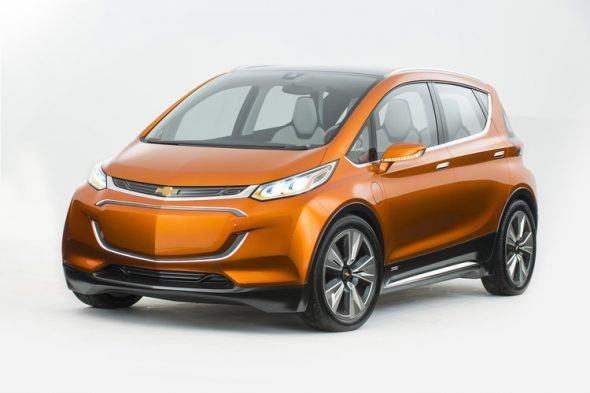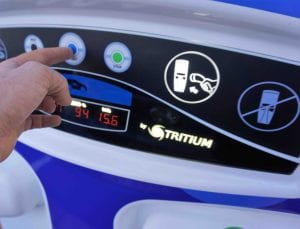The market for electric cars is warming up as more manufacturers prepare to bring new models to the showrooms.
General Motors is set to take on Tesla Motors with its Chevy Bolt electric car, which will be able to go 238 miles on a fully-charged battery, farther than the least-expensive versions of Tesla’s Model S sedan and possibly further than the much-anticipated Model 3 when it comes out.

The car, scheduled to begin sales later this year, is expected to be priced at $US37,500 before a federal tax credit of as much as $US7,500, the automaker said. Its range compares with 219 miles for Tesla’s lowest-priced Model S 60, which has a base price of $US66,000. Tesla CEO Elon Musk has said the Model 3, which is slated to go on sale late next year at a starting price of $US35,000, will be able to go at least 215 miles per charge.
The two companies have been making a case that their new electric cars will be the better option. GM has said the Bolt hatchback will have more cargo room than a Model 3 and can be repaired at any of 3,200 Chevy dealers, compared with Tesla’s 208 stores. Tesla has bragged that its styling and technological prowess have lured more than 300,000 people to put down deposits of $1,000 for the Model 3.
The dilemma facing countries that find themselves curtailing excess renewable power were shown one way forward this week by Germany and Norway. Power grid operators linking the two countries started work on the 2 billion-euro ($2.3 billion) Nordlink cable, which will allow excess electricity from wind farms to be stored for future use in hydro-electric dams, starting in 2020.
The 387-mile cable between the two nations will transmit as much as 1.4 gigawatts of power under the North Sea, linking wind farms in Germany with hydro plants in Norway. The project will allow both nations to profit by reserving excess power for times when demand and prices are higher.
Linking wind farms to storage allows the technology to qualify as “baseload” supply that’s able to dispatch when grid managers need it, said Robert Habeck, deputy prime minister of Germany’s Schleswig-Holstein state.
Meanwhile, European Union leaders gave a political nod to the fast ratification of the Paris climate accord, a step that could enable the pact to come into force less than a year after it was agreed to by more than 190 nations.
“Not only will the European Parliament vote in October; now all members of the European Union stand ready to ratify the accord as soon as possible,” French President Francois Hollande said Sept. 16 after an informal summit in Bratislava.
The most ambitious scenario sketched by the Slovak presidency of the EU assumes the approval procedure at the union level can be finished by Oct. 7, said Jos Delbeke, director general for climate at the European Commission. The fast-track route would need formal backing by the bloc’s 28 national environment ministers, with Slovakia calling an extraordinary gathering for Sept. 30. The EU Parliament’s next plenary session is scheduled for Oct. 3-6 in Strasbourg, France.
In Asia, coal-fired power generation was back in the limelight. China may be investing too much in coal power, with construction of new plants accelerating at the same time that demand-growth for electricity is slowing, the International Energy Agency said.
The world’s biggest investor in fossil-fuel generation started more than 70 gigawatts of new coal projects last year and had 200 gigawatts under construction at the end of April, the Paris-based institution said in a report published Sept. 14. At the same time, most plants are sitting idle more than half the time, and low-carbon sources of electricity including nuclear and renewables are covering additional demand.
As for projects, Vattenfall AB won a tender to build two offshore wind farms in the Danish North Sea with a record-breaking bid of 60 euros ($67.33) a megawatt-hour — 20 percent cheaper than the previous record set by Dong Energy A/S in the Netherlands in July. The total capacity of the projects is expected to be 350 megawatts, Sweden’s largest energy company said.
In the U.S., Tesla won a bid to supply grid-scale power in Southern California to help prevent electricity shortages following the biggest natural gas leak in U.S. history. The Powerpacks, worth tens of millions of dollars, will be operational in record time – by the end of this year.
Tesla will supply 20 megawatts (80 megawatt-hours) of energy storage to Southern California Edison as part of a wider effort to prevent blackouts by replacing fossil-fuel electricity generation with lithium-ion batteries. Tesla’s contribution is enough to power about 2,500 homes for a full day, the company said in a blog post on Thursday. But the real significance of the deal is the speed with which lithium-ion battery packs are being deployed.
“The storage is being procured in a record time frame,” months instead of years, said Yayoi Sekine, a battery analyst at Bloomberg New Energy Finance. “It highlights the maturity of advanced technologies like energy storage to be contracted as a reliable resource in an emergency situation.”
Source: BNEF. Reproduced with permission.









